In-depth Analysis of the AO Economic Model, Unveiling the Surprises of AO Step by Step!
Author: Biteye, Core Contributor Fishery
Editor: Biteye, Core Contributor Crush
*Full text about 4500 words, estimated reading time 10 minutes
As a decentralized computing system based on the Arweave platform, AO is capable of supporting high-concurrency computing tasks, making it particularly suitable for big data and AI applications. Its unique narrative has attracted a lot of attention. However, AO's outstanding points are not only its narrative, but also the following intriguing highlights, such as:
How does AO create a healthy chip distribution and bring about a money-making effect through a clever DeFi economic flywheel?
DAI mining yields more than double that of stETH, how do users participate in cross-chain mining AO?
How many outstanding performances does AO have, including win-win situations for the project party and users, unique narrative across the network, and innovative leadership in the DeFi track?
In this article, Biteye will answer the above questions and conduct an in-depth analysis of the AO economic model, unveiling the surprises of AO step by step!
01 Introduction to the AO Project
AO is a decentralized computing system based on the Arweave platform, using the Actor-Oriented Paradigm, aiming to support high-concurrency computing tasks.
Its core goal is to provide trustless computing services, allowing an unlimited number of parallel processes to run, and possessing high modularity and verifiability. Combining storage and computing, AO provides a solution superior to traditional blockchains.
On June 13, 2024, AO announced its token economic model, which is a fair issuance mechanism. This mechanism follows the "Zu System" and draws on the economic design of Bitcoin, while also innovating the concept of liquidity incentives in DeFi.
The innovative part is particularly clever, and its performance after the mainnet circulation is highly anticipated. It has an impressive economic model, which is also one of the top innovations in the DeFi field.
02 Token Issuance Rules
The total token supply of AO is set at 21 million, the same as Bitcoin, highlighting the scarcity of AO.
Token issuance adopts a mechanism of halving every four years, but through distribution every five minutes, it achieves a smoother issuance curve. The current monthly issuance rate is 1.425% of the remaining supply, and this rate will gradually decrease over time.
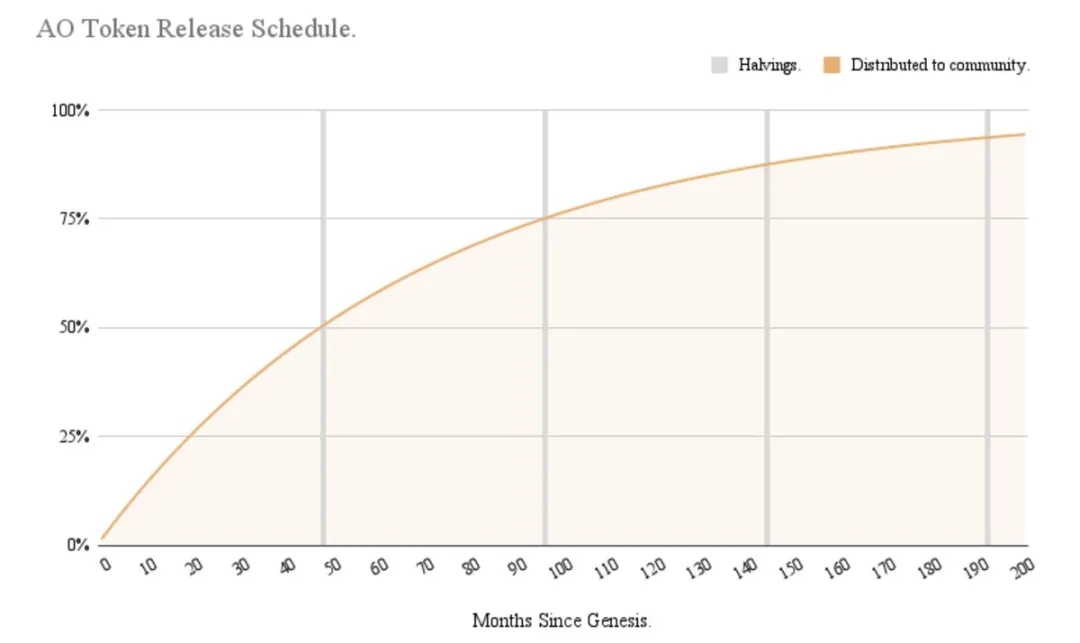
In this round of the bull market, where VC coins are listed in large quantities, AO is highly commendable for adopting a 100% fair issuance model, abandoning the common pre-sale or pre-allocation mechanism.
This decision aims to ensure that all participants have equal access to opportunities, in line with the original intention of decentralization and fairness pursued in the cryptocurrency field, with a very broad vision.
AO's token distribution rules can be divided into several key stages, each with its unique characteristics and goals:
Initial Stage (February 27, 2024, to June 17, 2024): In this stage, it can be understood as airdropping AO to AR holders. AO has adopted a retrospective minting mechanism. Starting from February 27, 2024, all newly minted AO tokens are 100% emitted to AR token holders, providing additional incentives for early AR holders. During this stage, one AR can receive an incentive of 0.016 AO tokens. If during this time, readers hold AR on exchanges or custodial institutions, they can inquire about receiving AO after its official circulation on February 8 next year.
Transition Stage (Starting from June 18, 2024): Starting from June 18, AO introduced a cross-chain bridge. In this stage, the newly minted AO tokens are divided into two parts: 33.3% continues to be distributed to AR token holders, while 66.6% is used to incentivize asset bridging to the AO ecosystem. Currently, users can participate in this stage of token distribution by depositing stETH (more asset categories will be added in the future). This is a major part of participating in the AO ecosystem, which will be further explained below.
Mature Stage (Estimated around February 8, 2025): This stage marks the maturity of the AO token ecosystem. When about 15% of the total supply (approximately 3.15 million AO tokens) has been minted, AO tokens will begin to circulate. The timing of this is set to ensure that there is sufficient liquidity and participation in the market before the tokens start trading. In this stage, the distribution rules remain stable, continuing to follow the 33.3% to AR holders and 66.6% for bridging incentives.
Overall, about 36% of AO tokens will be distributed to Arweave (AR) token holders during the entire emission process (100% before June 18 + 33.3% afterwards), which strengthens the close connection between AO and the Arweave ecosystem.
The remaining 64% is used to incentivize external income and asset bridging, aiming to promote the economic growth and liquidity enhancement of the ecosystem.
03 Economic Flywheel
The AO economic model also includes a very innovative ecosystem fund allocation mechanism, where users will continue to receive AO token rewards by bridging qualified assets across chains. It is very attractive to most people to be able to continuously receive DeFi income by simply making a cross-chain transfer. This fund bridge is the core of the AO economic flywheel and the source of revenue for the project party under the fair issuance mechanism.
This is a very new way of playing, worthy of detailed research. This section will clarify the principles for everyone.
First, it should be clear that assets that can obtain AO through cross-chain transfers need to meet two requirements:
High-quality assets: These assets must have sufficient liquidity in the market. They usually refer to assets from large public chains. This requirement ensures that assets bridged to the AO network have wide market recognition and utility value.
Annualized income: These assets must be tokens that can generate annualized income. Currently, stETH is a typical example. In the future, the team intends to introduce stSOL.
It is precisely these two requirements that are key to ensuring sustainable development and profitability for the project party while ensuring fair issuance of AO.
In simple terms, the principle is that users who keep these interest-bearing assets on the AO chain will pay the interest generated to the project party, and in return, the project party will mint AO for the user.
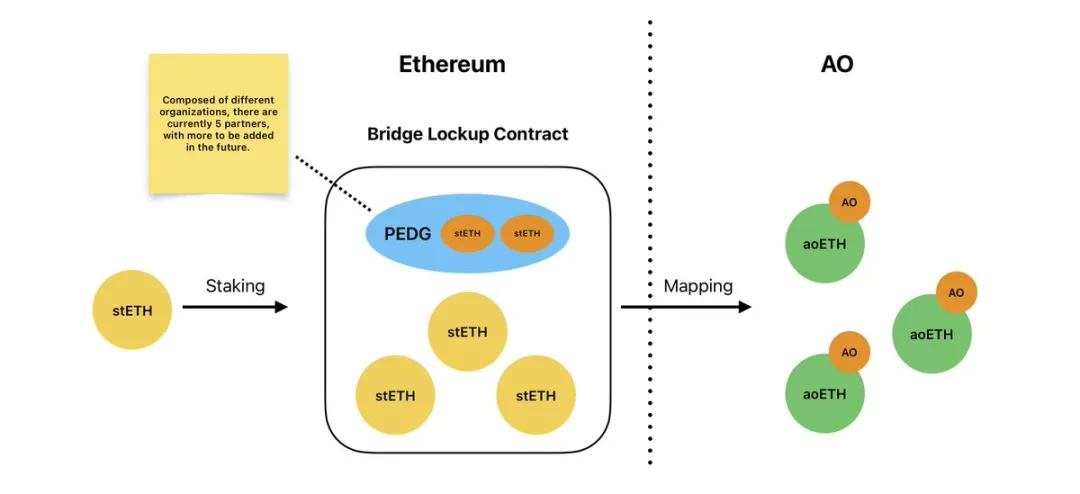
In the image, PEDG (Permaweb Ecosystem Development Guild) has received all the interest from stETH.
Specifically, taking stETH as an example, if a user stakes 1 ETH in Lido, they will receive 1 stETH. A key feature of stETH is that its balance will automatically increase over time, depending on the income generated by staking ETH. Correspondingly, stETH can be redeemed 1:1 for ETH, or traded back to ETH at a price close to 1:1 through the secondary market.
With an annualized yield of 2.97%, after one year, if this 1 stETH is left on the Ethereum mainnet without any action, the balance will increase to approximately 1.0297 stETH, which can then be exchanged back for 1.0297 ETH.
However, when this 1 stETH is bridged to the AO chain, the cross-chain bridge contract on the Ethereum mainnet will receive 1 stETH, and the user's AO chain address will receive 1 aoETH. It should be noted that aoETH will not increase in balance over time like stETH.
After one year, since the quantity of aoETH itself does not increase over time, the amount of stETH in the cross-chain bridge contract on the Ethereum mainnet will be greater than the total amount of aoETH on AO by the amount of interest for one year. Therefore, even if all aoETH on the AO mainnet is bridged back to the Ethereum mainnet (in an extreme case), there will still be a surplus of stETH in the mainnet contract, which is the source of revenue for the project party.
Currently, 151,570 stETH has been deposited into the AO cross-chain bridge. According to on-chain observations, the project team uses a bot to harvest at regular intervals, with daily earnings of approximately 12 stETH.
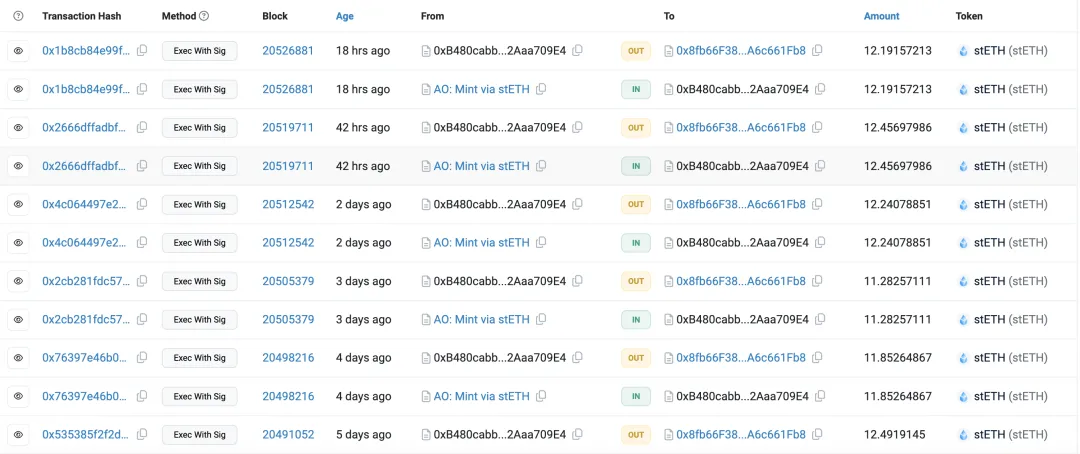
This is a win-win situation, achieving fair distribution of AO without the unattractive appearance of high FDV and low circulation VC coins, while also benefiting the project team.
At a 3% stETH interest rate, the team will profit from the interest generated by all stETH, approximately 4,500 ETH, and over 50 million DAI deposited in DSR at a 6% interest rate, totaling approximately over 10 million USD in earnings.
This is undoubtedly a very excellent mechanism for fair distribution, worthy of study by future projects.
The design of the AO economic flywheel is not limited to the above. In fact, the non-increasing balance of aoETH mentioned in the first half is not a supporting role; it is also an indispensable protagonist in the economic flywheel.
It should be noted that holders of aoETH will receive minted AO, making it an interest-bearing asset. Additionally, aoETH has a 1:1 price with ETH. Therefore, aoETH not only has the liquidity and price stability advantages of mainstream coins but also generates interest in AO, which many people are optimistic about.

Profit Attribution Context
Such high-quality interest-bearing assets naturally come with new gameplay.
The AO network has proposed an innovative "developer minting" model, overturning traditional project financing and distribution methods. This model not only provides developers with a new source of funding but also creates a low-risk investment path for investors, while driving the healthy development of the entire ecosystem.
When developers create DeFi projects on the AO network, they need to lock AO native tokens and cross-chain assets to provide liquidity.
At this point, cross-chain assets such as aoETH become the preferred liquidity target. Users lock aoETH in the developer's smart contract, increasing the total value locked (TVL) of the application and, more importantly, the minted AO tokens from the locked aoETH are transferred to the developer's contract.
This achieves "developer minting," providing continuous funding support for developers. It is not difficult to imagine that in the future, when stSOL is eligible for minting AO, the prospects for AO's DeFi will be even brighter.
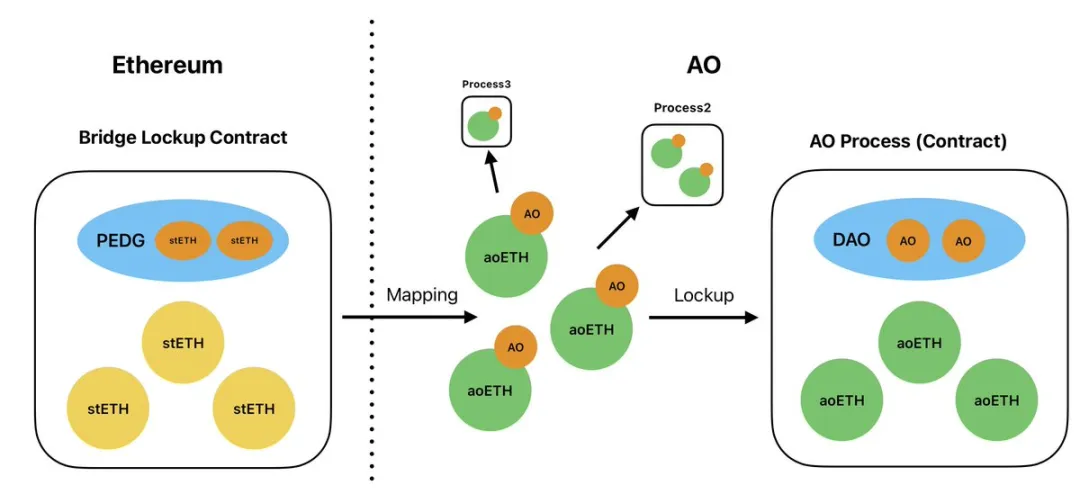
As a result, the project team is no longer overly dependent on VC funds, and chip distribution will be healthier. As the project develops and more aoETH is locked, developers will receive more AO tokens.
This will create a virtuous cycle: high-quality projects attract more funds, which in turn provide more resources to improve the product, ultimately driving the development of the entire ecosystem. As a result, the entire AO chain ecosystem will be healthier compared to the chain's ecosystem, leading to a money-making effect.
This innovative model not only simplifies traditional investment processes but also allows the market to more directly determine the flow of funds. Truly valuable applications will naturally attract more locked aoETH, thereby gaining more support in AO tokens.
This mechanism effectively integrates the interests of developers with the development of the ecosystem, incentivizing them to continuously create valuable applications.
This is undoubtedly a win-win situation. From the perspective of investors, using the annualized returns on their held assets (rather than the principal) to support projects greatly reduces risk and increases the intensity of investment.
Developers can focus on product development rather than spending a lot of time and effort on financing and chip distribution.
04 Participation Opportunities
Currently, the most stable way to obtain AO is through the official AO bridge cross-chain mining.
On September 5, DAI officially became the second asset that can mine AO after stETH.
Next, we will analyze how to participate in cross-chain mining AO from the perspectives of cost-effectiveness and security based on different risk preferences.
05 Cost-effectiveness
AO is not yet in circulation and does not have a price, so the APR cannot be calculated, making it a "blind mining" phase. Generally, "blind mining" is more attractive than deterministic DeFi.
Assuming the cross-chain mining of AO with 1,000 USD worth of stETH and DAI, we will compare the cost-effectiveness of the two based on the predicted amount of AO obtained.
The results are surprising!
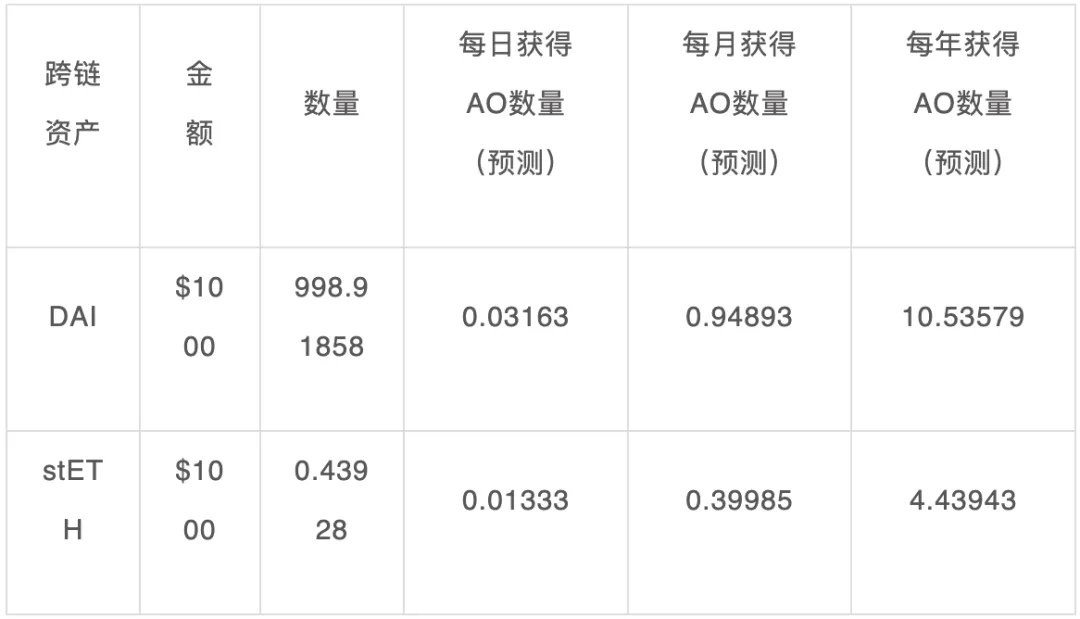
September 8th, DAI Mining AO Revenue Forecast Table
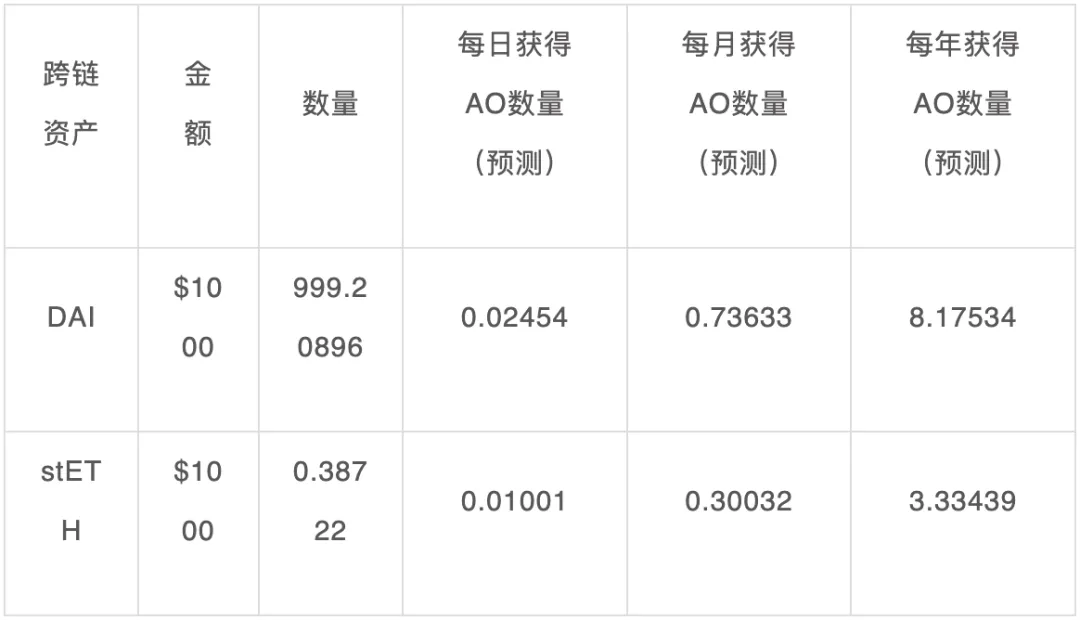
September 23rd, DAI Mining AO Revenue Forecast Table
Through the findings on September 8th and September 23rd, we made a jaw-dropping discovery:
On the third day of DAI mining on September 8th, which is still considered the early stage, the mining revenue of DAI and other amounts is 10.53579/4.43943=2.373 times that of stETH. As a legitimate project, the stablecoin's revenue is not only not less than that of risky assets but also multiple times higher, which is very rare in the DeFi market over the past few years.
At the time, the author also noticed this phenomenon and considered two possibilities: it was either too early, and the market had not yet reacted, or there was an implicit risk.
Now, nearly 20 days after the start of DAI mining, the market should have already digested the situation, but the revenue of DAI and stETH is still at 8.17534/3.33439=2.452 times, higher than on September 8th. It's unbelievable!
Excluding market reaction speed factors, there is only one consideration—
06 Risk
In terms of financial asset properties, the risk brought about by stETH price fluctuations should be much higher than that of DAI. Even for staunch believers in ETH, holding ETH firmly, they can still collateralize ETH, borrow DAI for arbitrage, at least offsetting the interest rate differential between the two. But the market is not doing this, which is very unreasonable.
Apart from financial risk, there is also contract risk.
As mentioned earlier, the stETH mining of AO has undergone a complex and clever design, allowing the team to receive all stETH earnings. Complex contracts bring risks, but fortunately, the core code of the stETH mining contract uses the code from MorpheusAIs project's Distribution.sol, which has stood the test of time. It is relatively safe.
The DAI mining contract, on the other hand, is a modification of the Distribution.sol by the AO team, which involves depositing DAI into DSR, making it several orders of magnitude more complex than collecting stETH.
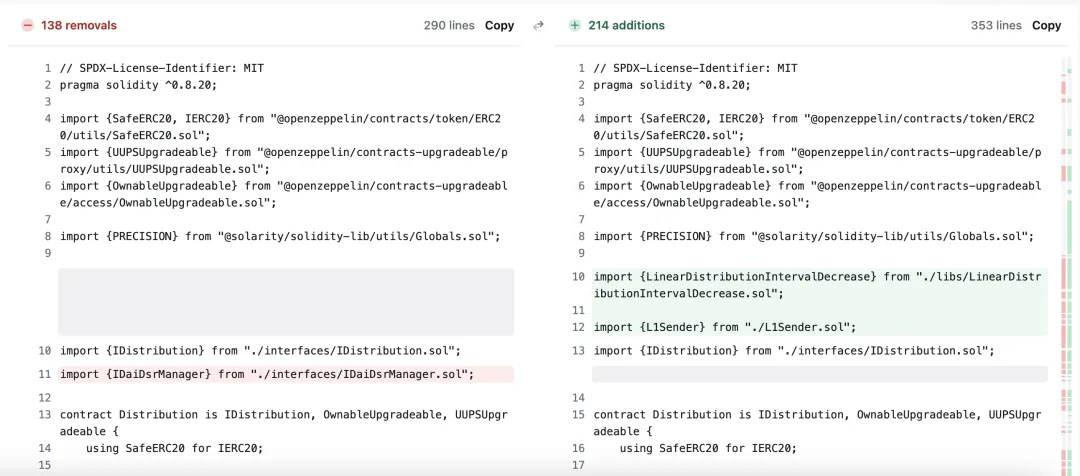
Comparison of DAI Mining Contracts MorpheusAIs Contract
Therefore, from the perspective of the contract, the stETH mining contract is much safer than the DAI mining contract, but this cannot fully explain the cost-effectiveness of DAI being more than double that of stETH. This requires further discussion. (A little advertisement, everyone is welcome to join the group for discussion!)
07 Conclusion
Overall, AO is highly anticipated, not only in terms of fair distribution but also in the "developer minting" model. It represents a new form of project, without VC dumping and cleverly designed from a DeFi perspective.
In terms of participation, Web3 must experience new things. However, when faced with incomprehensible situations (such as the excessive returns of DAI), caution and respect for the market's choices are also necessary.
免责声明:本文章仅代表作者个人观点,不代表本平台的立场和观点。本文章仅供信息分享,不构成对任何人的任何投资建议。用户与作者之间的任何争议,与本平台无关。如网页中刊载的文章或图片涉及侵权,请提供相关的权利证明和身份证明发送邮件到support@aicoin.com,本平台相关工作人员将会进行核查。




